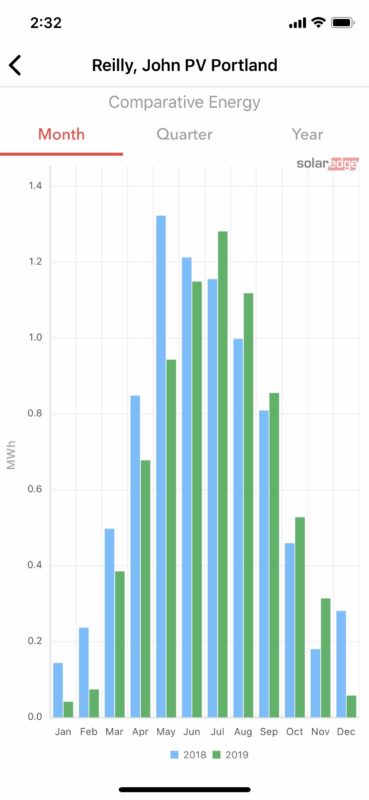I enjoyed pv magazine’s article (“MIT sees wind+solar going big, dreams of nuclear, forgets batteries exist”) on our paper about the role of nuclear power in deeply reducing carbon emissions from the electricity sector. But I assure you, we didn’t forget that batteries exist.
Energy storage is a complex combination of total capacity, duration, flow and cost. The article alludes to cost-effective batteries that might store power from the sun during the day to meet power needs at night. This may be close to the ideal system for battery storage, especially in a sunny location near the equator.
With likely lower power demands at night, one would have a predictable power supply during the day, not quite matching the tendency for usage to skew into the evening. Moreover, supply would be even throughout the year: you would only need enough storage from midday to meet significant evening demand, with a bit for low nighttime demand. In fact, our modeling of storage accounts for cost, capacity, duration and flow, the critical dimensions of any storage technology.
In terms of the results we get, the technology could be battery storage, pumped hydro or any other storage with those specifications. We used pumped hydro to cost our storage technology out, because it was the least costly option today. Whatever the storage option, it will have some cost that must be taken into account. And that cost will tend to rise the more capacity and longer storage required.
The problem , however, is that virtually no place in the U.S. is as ideal as the above example — certainly California and the desert Southwest come close, but even there the winter comes with shorter days, a lower sun angle and some cloudy days.
So here are some real numbers: I have a solar PV installation on my roof in Maine, along with a Tesla Powerwall able to store 12 kWh. My annual production has been 10 to 15% below what the system was supposed to produce.
More problematic for storage, I’ve produced 1.2 to 1.3 MWh in the late spring/summer months, but less than .1 MWh last Jan and Feb.— since the roof was covered with snow a good chunk of the time (see figure).

Even if it were sunny 31 days out of the month, the best I could generate through the winter months would be about .5 MWh per month, just due to the shortened day length and low sun angle. Unfortunately, the winter months are when I am using 1.3 MWh per month. I can set my Powerwall on self-power mode and hardly use power from the grid during the summer—the solar/battery example cited in the pv magazine article—except I’d be producing (and spilling) a huge amount of power that I couldn’t use.
Fortunately, I am connected to the grid and can carry credits from summer to winter. My maximum banked generation this year was 1.9 MWh. If I were to install enough Powerwalls to store the extra generation I produced over the summer, I would need about 160 of them. At $12,000 each that would be almost $2 million of investment in storage just for my single residence. Battery costs will have to come down a lot to make that calculation work in favor of storage.
The Powerwall makes sense for me to protect against outages—the $12,000 less the federal tax credit makes the battery competitive with a hard-wired generator. A photovoltaic solar system connected to the grid is still a good deal for me—I estimate an internal rate of return of 4% to 6% depending on whether the modules only last for the 25-year warranty or last another 10 beyond that.
But this investment calculation would fall apart if I was not hooked into the grid, where I take advantage of a power supplier with dispatchable power.
Admittedly, Maine is probably the other extreme from the desert Southwest, and grid scale operations are going to gather economies of scale I can never hope to get with a small residential installation. That’s why we constructed a model to carefully take into account the real variation in patterns of demand and supply over the course of hours in a day and over seasons—and also to exploit, through grid connection, favorable geographical patterns of different renewable supplies and patterns of demand, using what we believe are reasonable utility-scale costs.
Obviously, this provides a great advantage over the fully-off-the-grid calculation for my house, but it is hard to erase all of that supply and demand mismatch.
Finally, please note that our study finds that deep decarbonization without low-cost nuclear is entirely possible but is less expensive if we have a reliable, low-carbon, dispatchable generation option at a reasonable cost.
The views and opinions expressed in this article are the author’s own, and do not necessarily reflect those held by pv magazine.
This content is protected by copyright and may not be reused. If you want to cooperate with us and would like to reuse some of our content, please contact: editors@pv-magazine.com.








Low cost nuclear? Maybe it will be too cheap to meter like in the ’70s…
Yeah, until solar PV started to ‘interlope’ into the grid system, “too cheap to meter” was a convenient lie told to get public backing for nuclear power. Now we see what it (really) means this “too cheap to meter”. California in the early days of wind farms and solar PV projects had times in the months of March through May, when there was more than enough solar PV and wind generation online to actually ‘over generate’. This caused manic power dumping to other States at what one could say was negative dollars per MWh of generation. Pay to get rid of generation and at night, had to pay a premium for fueled generation imported from other States to keep the grid up at night. So, now CAISO “curtails” solar PV and wind generation during the day to avoid the “duck curve” throwing away non-fueled generation and contracting for “fueled” generation at a premium price for a ‘ramping’ generation resource to address changes in the grid demands. Just a lot of the same ol’ same ol’, lousy inefficient operation of the grid from the past. Could this be the main reason tiered electricity rates, TOU programs with electricity rate spiking is creating rates that go from $0.17/kWh to $0.31/kWh on a daily basis? It’s hard to see the price point of alternative energy and how cheap it has become when the grid operator of California operates the online generation facilities in such a manner, and the CPUC, CEC and the Legislature allow tiered rates from an average of $0.17/kWh to $0.31/kWh on electricity used depending on the time of day. All this when CAISO “determines” non-fueled generation needs to be shut down so more expensive power from fueled power plants is used to meet grid demands.
Interesting headline: “MIT responds: batteries are critical to the future electric grid, but they have their limits”
If one from MIT really wanted to go through a “Pro” vs “Con” of the current rote grid business model and the micro-grid with distributed energy storage system, one could find at least 52% more efficiency with local micro-grids than centralized fueled generation facilities distributing power over power corridors that have transformer losses end to end of from 15% to 25%.
Some actual numbers from a user: “So here are some real numbers: I have a solar PV installation on my roof in Maine, along with a Tesla Powerwall able to store 12 kWh. My annual production has been 10 to 15% below what the system was supposed to produce.”
He mentions snow on the panels during the winter months, so, lower sun radius during the day, shorter sun hours and with snow, negligible power production during the day. Maine, how close to the ocean and ‘sea spray’ is this array installed? 10 % to 15% could also be ‘how’ the array was mounted, flat to whatever the roof pitch is or were there actual standoffs installed to get the best solar PV harvest on average? Sea spray, dusting, bird droppings and bugs laying eggs on panels problems, all can cause a 10 to 15% drop in expected efficiency. Who’s panels are on the roof? Are they Tier 1 or are they Tier 2 panels? What is the round trip efficiency of his TESLA Powerwall, less than claimed by the company? I’ve noticed a lot of solar PV companies like to use the STC rating of the solar PV panels, when the PTC rating is more realistic when one puts these panels on a roof. If one looks at the specification sheet for the solar PV module, there is usually a STC and a PTC rating of the panels output. It just so happens the PTC output is right around 10% less average than the STC. So, is it reasonable to say the solar PV company didn’t use the PTC to calculate a more realistic power production for the system and that another 5% of the power is lost in the round trip efficiency of the ESS itself?
This brings up the cost equation. With solar PV panel prices at retail at from $1.25/watt to $0.80/watt, would it be sane to take into account such panel losses as orientation (not perfect) and using the PTC instead of the STC for system design and even taking into account an average dusting loss of 10% and energy storage system round trip efficiency could one come up with say 30% more panel capacity for a relatively service free installation, would this “break the bank” to over design for known losses over the system’s generation lifetime? As panel manufacturing costs come down and yields go up over the next few years, would one be able to over design a system at 50% and still have a decent ROI? I believe yes, the only limit would be (roof space) for the extra panels.
Agreed, a two million dollar personal investment in someone’s home battery backup is cost prohibitive. The problem here is that John is now pretending utility scale battery systems don’t exist, comparing a utility scale nuclear plant to someone’s personal home battery backup system. Why not assess the cost of installation and maintenance of a nuclear plant over 30 years to that of a utility scale powerpack system? Let’s compare utility scale system to utility scale system. Nobody has a personal nuclear power plant for their home either, that would be cost prohibitive.
Hi
It sounds like you heat with electricity in winter.
The available solution for your seasonal transfer issue is ice thermal storage. More common in Europe, but should lower your electricity cost in summer and winter.
Cheers
I am continually amazed that papers like this do not recognise the coming hydrogen economy. I do realise that his paper is based on other work that does not recognise hydrogen as a fuel of the future.
There is a huge amount of investment in hydrogen, and some say that the practical use of hydrogen is 10 years behind batteries. If that is the case by 2030 hydrogen will be a major component in supplying our energy needs. All major industrial countries now have a hydrogen strategy.
One major advantage of hydrogen as a fuel is that it can be easily stored – made in summer and used in winter, especially at a grid level. It will eventually replace LNG as it is a zero emissions fuel when made from renewable sources of electricity. With the cost of wholesale electricity going to zero during summer months the economics are hard to ignore. yet it is.
Why is it so?